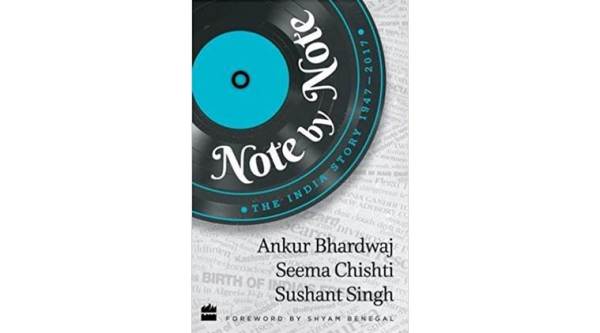Our music, our lives
A well-contextualised emotional history of India through iconic Hindi film songs

The book consists of short chapters, one for each year of independent India’s history, centred on one Hindi film song that was composed and widely heard during the year.
Title: Note by Note: The India Story 1947-2017
Authors: Ankur Bhardwaj, Seema Chishti and Sushant Singh
Publisher: Harper Collins
Pages: 327
Price: Rs 499
Authors: Ankur Bhardwaj, Seema Chishti and Sushant Singh
Publisher: Harper Collins
Pages: 327
Price: Rs 499
The relationship between politics and culture is seldom straightforward. Yet, in the case of India, it is widely held that the Hindi film is a receptacle for the dizzying diversity of the country and has played some role in forging national unity. As the writer and lyricist Javed Akhtar once observed, Hindi cinema is practically another state in the Union of India. It is tempting, too, to think of the Hindi film as holding up an oblique mirror to the development of the nation. But there are few convincing historical accounts of this nexus.
Ankur Bhardwaj, Seema Chishti and Sushant Singh do not aim to provide such analysis. Note by Note, they write, is akin to “an old-fashioned bioscope where the vignettes of India’s story over the past seven decades are played to Hindi film music.” The book consists of short chapters, one for each year of independent India’s history, centred on one Hindi film song that was composed and widely heard during the year. The choice of songs is meant to capture the “overall mood and groove of the year”. To their credit, the authors do not attempt to shoe-horn their choice of music into contemporary political developments. Rather, they juxtapose short analyses of the songs with thumbnail sketches of history as it unfolded.
The authors’ approach and treatment appears to be influenced by Eduardo Galeano’s classic Football in the Sun and Shade — an unabashedly “emotional history” of World Cup football by an ardent admirer of the sport. Indeed, this book might best be read as an emotional history of the Indian republic through the Hindi film song.
Shamshad Begum’s song in Ghar ki Izzat (1948), “Desh hua aazad magar/Na pahna tune taaj”, was an homage to Mahatma Gandhi. The song was not originally part of the script, but was included in the traumatic aftermath of Gandhi’s assassination. Here was an instance of the Hindi film being directly influenced by politics. The opposite could occasionally be true as well.
The authors pick the song for 1975 from the film Aandhi, “Tere bina zindagi se koyi shikwa toh nahin”, partly because of its surprising impact. Although the film was publicised as being loosely based on the life of Prime Minister Indira Gandhi, it was released without a hiccup. But the film was banned after running for 20 weeks. The move was triggered by the Gujarat assembly election campaign in which opposition candidates started showing scenes of the film’s lead character smoking and drinking to malign Indira Gandhi. The ban prefigured the imposition of the Emergency later that year.
In several interesting chapters, the authors point out how the popular song of the year echoed, even if distantly, the mood of politics. For 1952, when the Congress won the first general election and inaugurated the Nehruvian era, they showcase the song “Mann tadpat Hari darshan ko aaj” from Baiju Bawra. Written by Shakeel Badayuni, composed by Naushad and rendered by Mohammed Rafi, the song “spoke eloquently to the times”. As in its own way did the number “Anhoni ko honi kar dein, honi ko anhoni”, from Amar Akbar Anthony, released in 1977, just as the Congress was defeated at the Centre by an alliance of assorted opposition parties.
Politics, too, impinged on the Hindi film song in other, more subtle ways. For instance, it is striking to see how many of the songs listed up to the 1970s were products of artistes who had, at one point, been associated with the Indian People’s Theatre Association, a cultural front organised by the Communist Party of Indiaduring World War II. I was particularly gratified that the authors acknowledged the contributions of the incomparable Salil Chowdhury. By contrast, the creative energies unleashed by the political conjuncture of the late 1960s and early ’70s were initially channelled into art house, not commercial, cinema.
Beyond such suggestive connections, the authors also show a keen sense for the subtleties of their songs. Take “Kai baar yunhi dekha hai” from the 1974 film Rajnigandha. The song sought to capture the leading character’s conflicting emotions about two men in her life — a theme that seems ahead of its times. Equally interesting is the fact, they note, that the emotional dilemma of the heroine is captured by a male singer who provides the voice for her predicament.
The 1980s, the authors write, inaugurated a “phase of banal and crass lyrics (which) seemed to reflect similar tones in political exhortations.” Having grown up with Hindi film music of this period, I am happy to concur with this judgement. But the later chapters of the book don’t work quite as well, partly because this period is too close to us and our political judgements are necessarily more tentative. I wonder if it is also partly because the Hindi film song doesn’t have the cultural hegemony that it once commanded. But these are distractions. The book should be enjoyed for what it offers: a wonderful and well contextualised playlist and a delectable “emotional” tour through India’s date with democracy.
The writer is senior fellow at the Centre for Policy Research, New Delhi
For all the latest Lifestyle News, download Indian Express App






















No hay comentarios:
Publicar un comentario